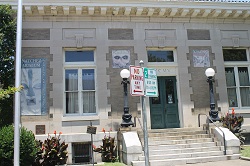Natchez Museum of African-American History and Culture
Natchez Museum of African-American History and Culture
 Artwork, literature, and artifacts relating to the lives of African Americans in Natchez
Artwork, literature, and artifacts relating to the lives of African Americans in Natchez
301 Main Street
Natchez, Mississippi

 Artwork, literature, and artifacts relating to the lives of African Americans in Natchez
Artwork, literature, and artifacts relating to the lives of African Americans in Natchez
301 Main Street
Natchez, Mississippi
The Hurricane Plantation at Davis Bend near Vicksburg offered a rare exception to harsh reality of slavery. The 350 enslaved people there had access to adequate food, shelter, medical care, and could read and write. However, Davis believed that “the less people are governed, the more submissive they will be to control.”
Pictured: A black and white photograph of the home of Joseph Davis. The home has ten columns. In front of the columns are 38 enslaved people and three members of the Davis family (far left).
As Southern states became slave societies, the need for more labor grew exponentially. Natchez’s Forks of the Road became the second largest slave market in the Deep South. Slave owners came from across the nation to Natchez to buy more slaves, many of whom were sold away from their loved ones.
Pictured above: A hand drawn map of Forks of the Road using ink on paper. The ink is blue and the paper has yellowed with age. Forks of the Road appears in the center of the drawing, where all roads come together.
During the Civil War, some 78,000 Mississippians fought for the Confederacy. In 1863, Union soldiers occupied Jackson, destroyed Confederate resources, and burned much of the city. Seventeen thousand Black Mississippians would join the Union ranks, some of whom fought in Grant’s campaign to capture Vicksburg or were stationed at Ship Island.
Pictured: A drawing of the Battle of Jackson. Troops form a semi-circle in the center of the image. Thin trees line the left side. A home on a small property is in the background.